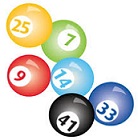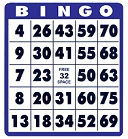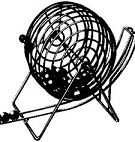|
||||||||||||||||||||||||||||||||||||||||||
|
| ||||||||||||||||||||||||||||||||||||||||||
|
USA Bingo Learn everything you need to know about the game of Bingo in the USA, from how to play, to history and variations. Bingo in the USA is a game of chance where players
match numbers printed on 5-by-5 cards with randomly drawn numbers drawn
by the game operator. Player's cover the matching numbers on their cards
with tiles or mark them as the numbers are called, and call out "Bingo!" when the
selected numbers are arranged in a row. This alerts all
players and the operator that there is a winning
Bingo Cards The most common bingo cards used are pieces of card or paper with a grid of 25 boxes arranged in five rows and five columns with each box containing a number. Typically, each game will use the numbers 1 to 75. The
five columns on the card
The total number of all possible US standard Bingo cards is: P(15,5) × P(15,5) × P(15,5) × P(15,5) × P(15,4) = 552,446,474,061,128,648,601,600,000 or approximately 5.52×1026. Players win by marking off a row, column, or diagonal series of numbers. The most number of numbers marked on a Bingo card without having a Bingo win is 19, excluding the free space. For this to happen, only one empty space can reside in each row and each column, and at least one empty space must be in each diagonal: As well as a straight line, other patterns may be considered a valid win in special games. For example, 2×2 square of marked numbers in the upper-right-hand corner would be considered a "postage stamp". Another common example requires players to cover all the four corners. There are a number of other patterns, such as a "Roving L", which requires a player to cover all B's and top or bottom row or all O's and top or bottom row. Another common pattern known as a "blackout", covers all 24 numbers and the free space. Gameplay
The random numbers called in a game of bingo may be drawn using various
different methods. With the
increased use of computer technology in bingo,
Individual bingo games often have more than one win/claim, with players playing for a single line, then a full card, and then continuing for a full consolation card. Often players play a number of cards for a game and 30 is not unusual. Because each player may have a large number of cards, most bingo halls will have players sat at tables where they may fasten their cards with sticky tape. To speed up the process of marking cards players usually use "daubers" which are like special thick soft tip pens. Commercial bingo calls will display the next number on a TV monitor, however, "bingo" may not be called until the caller has called the number aloud.
Bingo TerminologyReady/Cased/Waiting/Set/Down/Chance – When a player only needs one number to be drawn and matched in order to complete a Bingo pattern, they are considered to be Ready, Cased, Waiting, Set, or Down, or to "have a chance". Breaking the Bubble or "Possible" – The bubble is the term referring to the minimum number of drawn numbers required to complete the Bingo pattern. For example: 1 hard way bingo, a single straight line without the free space. The minimum number of called numbers is five or four if each number is under "N" on the card, although not considered "Breaking the Bubble" or "possible" until one number in each column or four/five numbers in a single column have been drawn and called. Jumping the Gun – When a player calls bingo before having a valid bingo pattern on their card. Mostly happens when a player is using the next number on the screen before it has been called by the caller. Wild numbers – Many bingo operators will offer certain games with a "wild number". Wild numbers allow players to start with multiple called numbers. Usually the first number drawn will be the determining factor. Standard – Numbers drawn ending with the second digit of the first drawn number. For example, if the number drawn is 22 then all numbers ending in a 2 including B2 is considered a drawn and called number. Forwards/backwards – Numbers drawn begnning or ending with the wild number. For example: If the first number drawn is 22 then all numbers beginning or ending with a 2 are considered a called number. However If the first drawn number ends with an 8, 9, or 0, another number may be drawn because there are no bingo numbers starting with an 8 or 9 and only 9 numbers starting with a 0. Some operators may also redraw a number ending with a 7 because are only six numbers beginning with a 7. False Alarm or Just Practicing– These terms are used when a player calls "bingo" by mistake. It could be because the player has misheard the caller or because they have marked the wrong number by mistake. A player who calls a "falsie" genuinely believes he has a bingo claim. These are also known as "social errors." or sometimes a "bongo." Hard Way Bingo – A hard-way bingo is a winning bingo pattern in a straight line not including the free space. Reach - In Japan, players call out "Reach" when they are one space away from a bingo.
|
|||||||||||||||||||||||||||||||||||||||||
|
Copyright © 2022 Stormdark I.P. and Media. All rights reserved. www.draw-play.net This site is for personal use only and content may not be copied or reproduced in any form for any purpose. Terms & Conditions Advertising |
||||||||||||||||||||||||||||||||||||||||||

 card and the operator's
representative then verifies the winning card and claim. All players
compete with one another to be first with a winning arrangement of
numbers to win a prize or jackpot.
card and the operator's
representative then verifies the winning card and claim. All players
compete with one another to be first with a winning arrangement of
numbers to win a prize or jackpot. will be labelled from left to right with the
letters 'B', 'I', 'N', 'G' and 'O'. The centre box in the middle of the
grid will usually be marked as 'Free' or 'Free Space' and is considered
automatically filled. The range of numbers printed on the card is
usually restricted by column, with the first 'B' column only containing
numbers from 1 to 15, the 'I' column only containing 16 to 30, 'N'
containing 31 to 45, 'G' containing 46 to 60, and the last 'O'
containing 61 to 75.
will be labelled from left to right with the
letters 'B', 'I', 'N', 'G' and 'O'. The centre box in the middle of the
grid will usually be marked as 'Free' or 'Free Space' and is considered
automatically filled. The range of numbers printed on the card is
usually restricted by column, with the first 'B' column only containing
numbers from 1 to 15, the 'I' column only containing 16 to 30, 'N'
containing 31 to 45, 'G' containing 46 to 60, and the last 'O'
containing 61 to 75. electronic random
number generators are now
common in most jurisdictions. However, some jurisdictions require
the old-fashioned mechanical ball draws which may utilize a randomly shuffled deck of
cards, a mechanical ball machine that mixes numbered ping pong-type balls
with blown air or a cage which is rotated to mix small balls. All
the different methods generate a random series of numbers for players
to match to their bingo cards.
electronic random
number generators are now
common in most jurisdictions. However, some jurisdictions require
the old-fashioned mechanical ball draws which may utilize a randomly shuffled deck of
cards, a mechanical ball machine that mixes numbered ping pong-type balls
with blown air or a cage which is rotated to mix small balls. All
the different methods generate a random series of numbers for players
to match to their bingo cards.